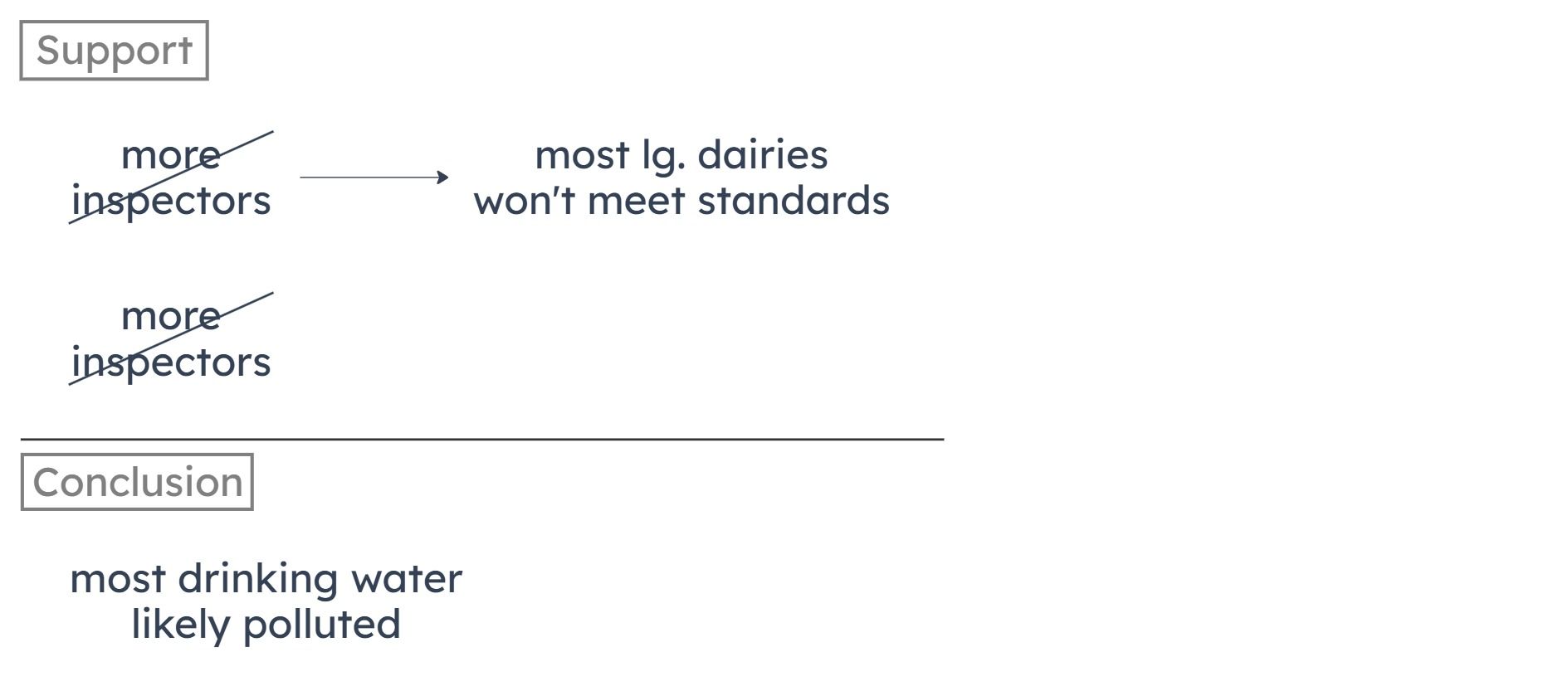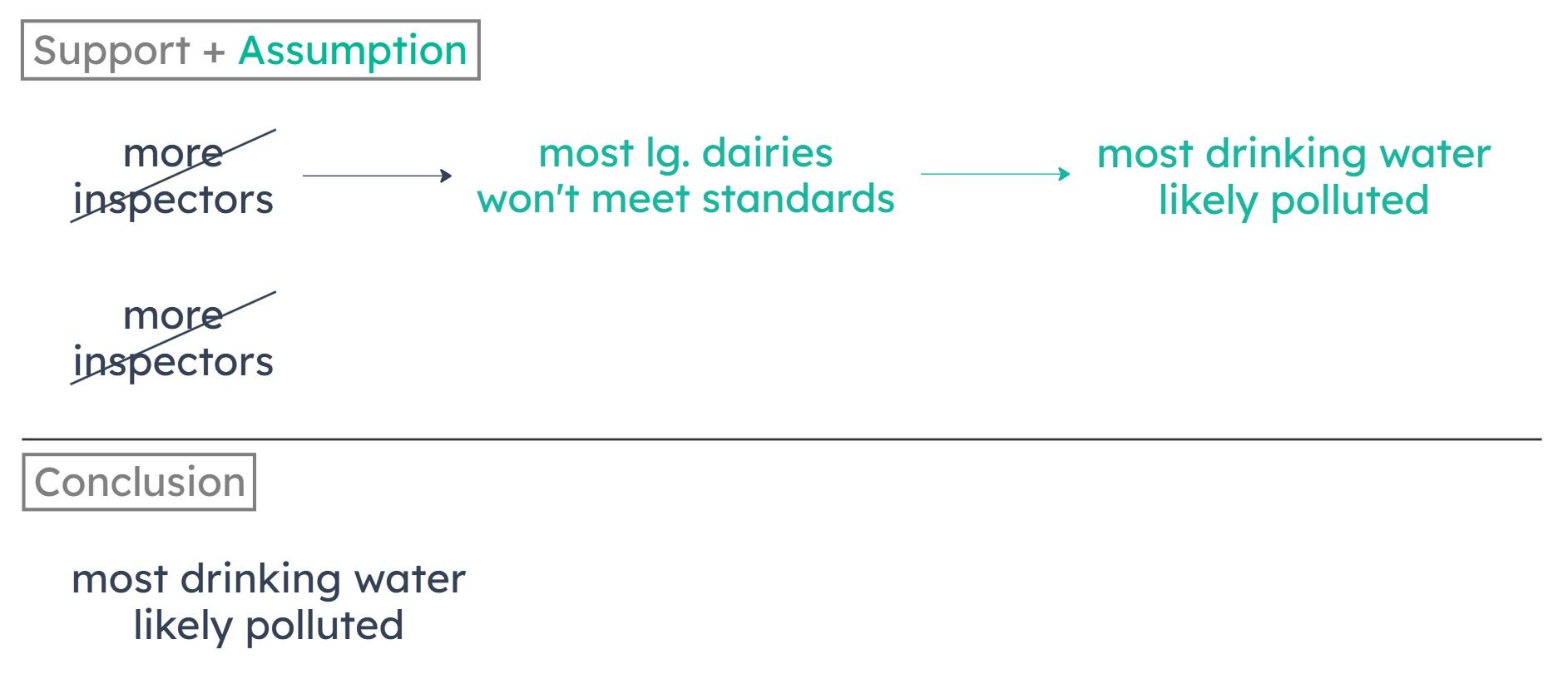LSAT 140 – Section 2 – Question 22
LSAT 140 - Section 2 - Question 22
December 2013You need a full course to see this video. Enroll now and get started in less than a minute.
Target time: 1:25
This is question data from the 7Sage LSAT Scorer. You can score your LSATs, track your results, and analyze your performance with pretty charts and vital statistics - all with a Free Account ← sign up in less than 10 seconds
| Question QuickView |
Type | Tags | Answer Choices |
Curve | Question Difficulty |
Psg/Game/S Difficulty |
Explanation |
|---|---|---|---|---|---|---|---|
| PT140 S2 Q22 |
+LR
+Exp
| Sufficient assumption +SA Conditional Reasoning +CondR Quantifier +Quant Link Assumption +LinkA | A
5%
157
B
12%
158
C
2%
157
D
76%
165
E
6%
159
|
146 154 162 |
+Harder | 149.441 +SubsectionMedium |
J.Y.’s explanation
You need a full course to see this video. Enroll now and get started in less than a minute.
Summary
The author concludes that most of the district’s drinking water is likely to become polluted. This is based on the fact taht the new district budget doesn’t allow for hiring of more dairy inspectors, and if that’s the case, then most large dairies in the central valley will not meet federal standards.

Missing Connection
The premises allow us to conclude that most large dairies in the central valley won’t meet federal standards. But how do we get from this inference to the conclusion that most of the district’s drinking water is likely to be polluted? We want to supply the following relationship:
If most large daries in the central valley don’t meet federal standards, then most of the district’s drinking water is likely to be polluted.
If most large daries in the central valley don’t meet federal standards, then most of the district’s drinking water is likely to be polluted.
A
If most of the dairies in the central valley meet federal standards for the disposal of natural wastes, it is unlikely that most of the district’s drinking water will become polluted.
We’re looking for the claim that if most of the dairies in the central valley DON’T meet federal standards, it’s likely that the water WILL be polluted. (A), however, tells us what happens if most of the dairies DO meet federal standards. This doesn’t establish what happens if most of the dairies DON’T meet federal standards.
B
To keep all the drinking water in the district clean requires more dairy inspectors to monitor the dairies’ disposal of natural wastes.
Even if (B) could establish that we can’t keep “all” of the drinking water clean, this doesn’t guarantee that “most” of the drinking water is likely to be polluted. For example, perhaps only 1% of the water is unclean. This wouldn’t be a situation in which most (over half) of the drinking water is polluted.
C
All of the district’s drinking water is likely to become polluted only if all of the large dairies in the central valley do not meet federal standards for the disposal of natural wastes.
(C) reverses something that would be correct. “Only if” introduces a necessary condition. But we want to know that failure to meet federal standards is sufficient to make most of the drinking water likely to be polluted.
D
Most of the district’s drinking water is likely to become polluted if most of the large dairies in the central valley do not meet federal standards for the disposal of natural wastes.
We know from the premises that most large dairies in the central valley don’t meet federal standards. (D) tells us that if that is the case, most drinking water is likely to be polluted. 

E
If none of the large dairies in the central valley meets federal standards for the disposal of natural wastes, most of the district’s drinking water is likely to become polluted.
We do not know from the premises that “none” of the large dairies in the central valley meet federal standards. So the premises would not interact with the conditional in (E). We still would not know whether most of the drinking water is likely to become polluted.
Take PrepTest
Review Results
LSAT PrepTest 140 Explanations
Section 1 - Logical Reasoning
- Question 01
- Question 02
- Question 03
- Question 04
- Question 05
- Question 06
- Question 07
- Question 08
- Question 09
- Question 10
- Question 11
- Question 12
- Question 13
- Question 14
- Question 15
- Question 16
- Question 17
- Question 18
- Question 19
- Question 20
- Question 21
- Question 22
- Question 23
- Question 24
- Question 25
Section 2 - Logical Reasoning
- Question 01
- Question 02
- Question 03
- Question 04
- Question 05
- Question 06
- Question 07
- Question 08
- Question 09
- Question 10
- Question 11
- Question 12
- Question 13
- Question 14
- Question 15
- Question 16
- Question 17
- Question 18
- Question 19
- Question 20
- Question 21
- Question 22
- Question 23
- Question 24
- Question 25
- Question 26
Section 3 - Logical Reasoning
- Question 01
- Question 02
- Question 03
- Question 04
- Question 05
- Question 06
- Question 07
- Question 08
- Question 09
- Question 10
- Question 11
- Question 12
- Question 13
- Question 14
- Question 15
- Question 16
- Question 17
- Question 18
- Question 19
- Question 20
- Question 21
- Question 22
- Question 23
- Question 24
- Question 25
- Question 26
Leave a Reply
You must be logged in to post a comment. You can get a free account here.